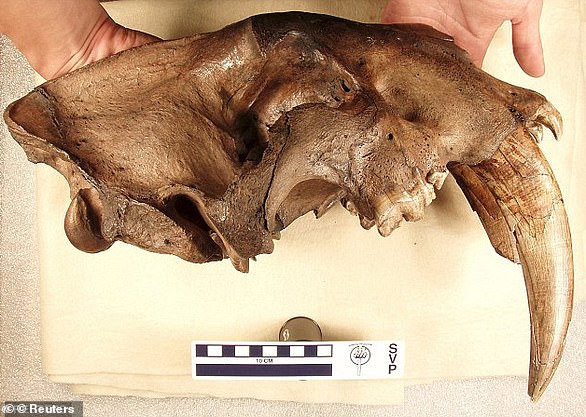Meet the Siberian Simba: Perfectly preserved saber-toothed KITTEN is discovered mummified in the Arctic permafrost, 37,000 years after it died
Scientists exploring the Arctic were in for a surprise when they discovered a perfectly preserved saber-toothed cat.
According to researchers from the Russian Academy of Sciences, the kitten was mummified in the permafrost as early as 37,000 years ago.
In their new study, published in Scientific reports, the team has revealed unprecedented details of this long-extinct animal.
Despite having died during the last ice age, the three-year-old kitten’s head, front legs, torso and paws were kept in near pristine condition by the cold.
The team found that its neck was twice as thick as that of a modern lion cub.
Meanwhile, his jaw was specially modified to hold his iconic conical incisors.
The scientists even discovered how the kitten’s ‘bean-shaped’ toes might have helped it walk through the snow of the last ice age.
In their study, the researchers write: ‘For the first time in the history of paleontology, the appearance of an extinct mammal that has no analogues in modern fauna has been studied.’
Scientists have discovered a perfectly preserved sabre-tooth kitten (pictured) buried in Siberian permafrost 37,000 years after its death
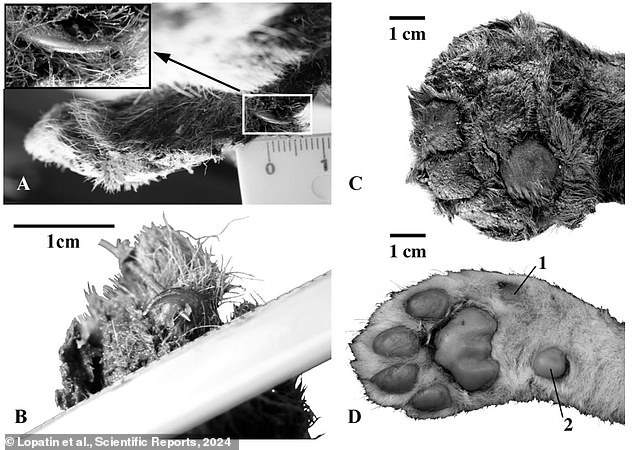
The researchers say the sabre-tooth tiger’s (pictured) paws were much wider than those of a lion (bottom right) so it could spread its weight as it walked across deep snow
During a 2022 expedition, scientists found the remains of the mummified kitten frozen in a block of ice in the Badyarikhskoe region of the Russian republic of Yakutia.
For unknown reasons, only the top half of the body was found in one piece.
However, the kitten’s incomplete femur and tibia were also found relatively intact nearby.
Although it is not clear how the kitten died, researchers believe it could have lived during a period called the Late Piocene, when the Earth was covered in huge ice sheets.
Previous studies have found ‘countless’ woolly mammoth bones in the soil of this area, but this is the first time such a completely frozen specimen of any species has been found.
Lead author Dr Alexey Lopatin and his colleagues write: ‘Findings of frozen mummified remains of Late Pleistocene mammals are very rare.’
Normally, the bones of animals from this period are scattered by scavengers and the elements long before they can be found by scientists.
This means that we still don’t know much about the animals that walked the Earth during the last ice age.
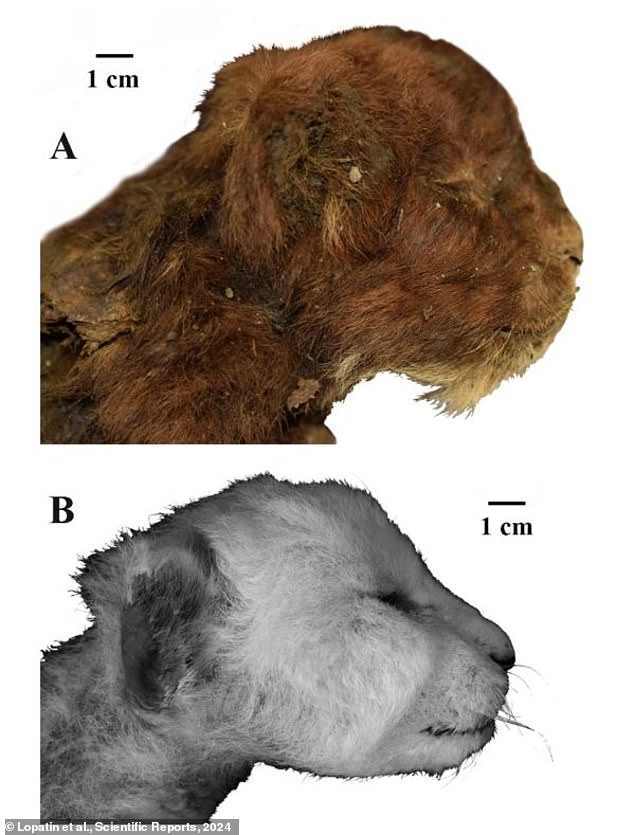
Compared to a lion cub of the same age (below), the saber-toothed kitten (above) had a wider jaw, a flatter snout and a muscular neck that was twice as thick as a lion’s.

Scientists found the perfectly preserved specimen in 2022 while digging in the permafrost of the Badyarikhskoe region in the Russian republic of Yakutia (photo)
However, thanks to this discovery, researchers now have a unique insight into the development of this iconic species.
The saber-toothed kitten is covered in a coat of dark brown fur that the scientists describe as “short, thick, soft” and is longer over its neck and back.
The kitten also has a short, wavy beard growing around its chin and two rows of fine whiskers.
When comparing the mummified saber-tooth tiger with a modern lion cub of a similar age, the researchers noted some distinct differences.
Most notably, the mummified kitten was significantly more muscular and had a “very massive neck” and an unusual snout shape that is significantly wider than that of a modern lion.
These, and other important adaptations, are thought to have allowed the sabre-tooth tiger to grow its enormous canines.
Dr. Lopatin and his co-authors write: ‘One of the striking features of the morphology of Homotherium, both in adults and in the cub studied, is the presence of an enlarged premaxillary bone.’
This bone, located in the front part of the upper jaw, would have allowed the kitten to grow a row of large conical incisors.
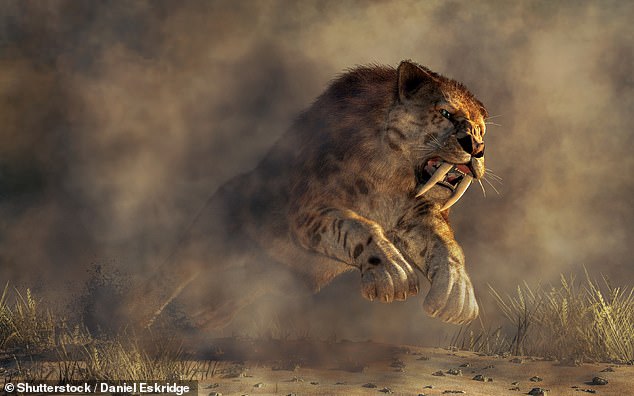
The sabre-tooth tiger hunted large mammals such as aurochs and deer, which lived in modern-day Siberia during the last ice age. The researchers discovered several adaptations that could have allowed these hunters to survive the cold and grow such large teeth
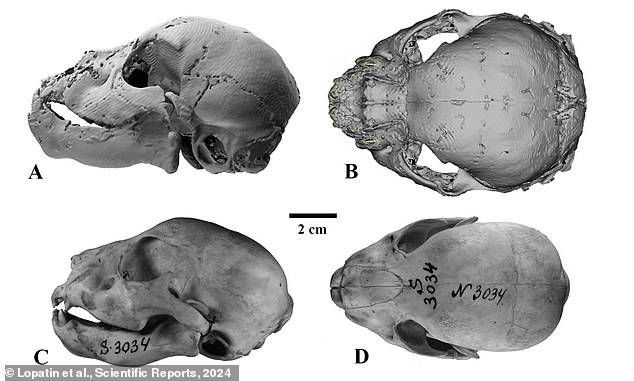
Images A and B show a scan of the saber-toothed cat’s skull, while C and D show that of a modern lion. You can see that the sabretooth’s skull is shorter and rounder, with a much larger jaw
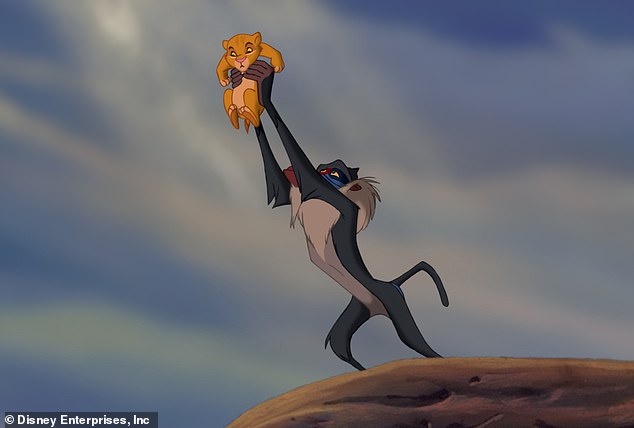
Unlike in ‘The Lion King’, this Siberian Simba had to wait tens of thousands of years for their time in the spotlight
However, this particular kitten was too young to grow its impressive canines, as scans showed it still had some baby teeth.
Furthermore, the incredible preservation of this specimen reveals the interesting ways in which the big cat adapted to its frozen environment.
In addition to thick fur and small ears that help reduce heat loss, the sabre-tooth mummy had wide legs to distribute its weight over the snow.
Similarly, the baby cat lacked carpal pads, thick pads of skin at the back of the wrist joint, which scientists say help them walk in deep snow.
This big cat, homotherium latidens, is the only species of its genus known to live in Eurasia during this period.
Comparisons with species found in Spain suggest that the country probably hunted large prey animals such as aurochs and deer.
But finding this specimen so deep in Siberia suggests they may have spread much further north than previously expected.
For now, the researchers have only identified the most obvious and unusual features of the mummified cat, but they are already planning more research to discuss the cub’s anatomy in much more detail.

